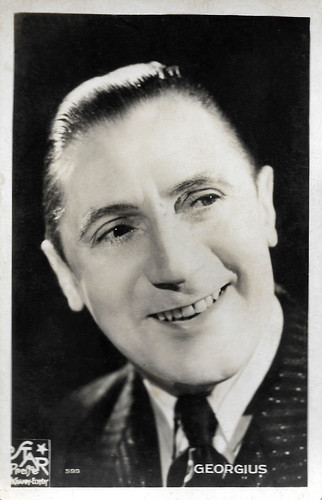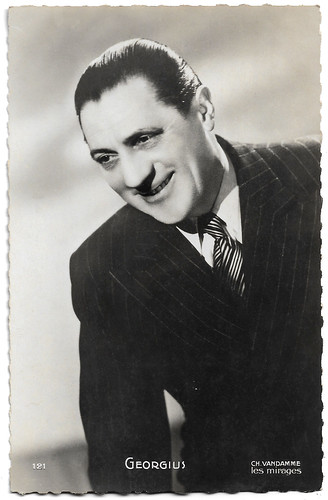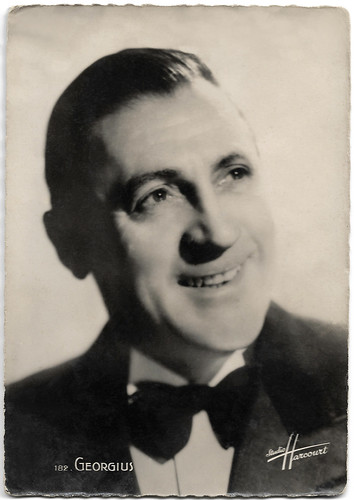
French postcard by EC (Editions Chantal), no. 33. Photo: Studio Piaz, Paris.
A veritable phenomenon of the music hall
Georgius was born Georges Auguste Charles Guibourg in 1891 in Mantes-la-Ville, Yvelines, France. He was the son of Georges Charles Joseph Guibourg, a schoolteacher, editor of the Petit Mantais and then editor-in-chief of the weekly newspaper La France aérienne, and Clémentine Augustine Bouteilly.
He began studying the piano at the age of 11 and at age 16 went to Paris where he performed on stage, singing extracts of traditional operettas and lovesongs. Over the next few years, his various engagements with cabarets progressed. He began to write comic songs.
It was in 1912 that he really began his career as a chansonnier. Called to the Gaîté-Montparnasse theatre to replace a comic singer, his songs were so popular that the theatre signed him a contract for a year; he remained there for three years.
In 1916 he began writing plays, which he then performed with his troupe, Les Joyeux Compagnons, created in 1919. In the 1920s and 1930s, he was a veritable phenomenon of the music hall. His best-known song at the time was 'La Plus Bath des javas', a parody of fashionable javas. He continued to tour and put on revues with his troupe, which was renamed the Théâtre Chantant in 1926.
During this inter-war period, he became one of the most popular singers in Paris, performing at the Moulin Rouge, Bobino, Alhambra Club and the Casino de Paris. 1930 was a great year for him: he released 'La Route de Pen-Zac', which sold more than 160,000 records, a record for the time! The shows followed one another, and everyone rushed to see him.

French card by *Star Presse, Paris, no. 595. Photo: *Star.

French postcard by Editions P.I., no. 121. Photo: *Star.
More than 1,500 songs, 2,000 sketches, numerous screenplays and a dozen detective novels
Georgius wrote and played the leading role in his film debut, the farce Pas de femmes?/No Women? (Mario Bonnard, 1932) with Aimos and the young Fernandel in a supporting part. He wrote the story for the short Maison hantée/Haunted House (Roger Capellani, 1933) with Monette Dinay and Paulette Dubost.
He co-starred with Dolly Davis in Un train dans la nuit/The Ghost Train (René Hervil, 1934). Throughout the 1930s he appeared in nine escapist comedies. In 1936, he had another success as a singer, with the song 'Au Lycée Papillon', which also broke sales records. It had a verse that is no longer sung today because it was anti-Semitic.
Other hits followed: 'Ca c'est de la bagnole' and 'On ne peut pas plaire à tout le monde'. In 1938 he wrote and performed a comic song against Adolph Hitler:' Il travaille du pinceau' in which he made fun of the house painter (Hitler was a painter in his youth). He continued his revues during the war. In 1941, he played Sganarelle in Moliere's 'Le Médecin malgré lui' at the Comédie-Française. In 1941 and 1942, he was the artistic director of three theatres: the Théâtre de l'Étoile, the Théâtre Antoine and the Théâtre de l'Ambigu.
After the war, he was banned from the stage for a year by the Comité National d'Épuration du Spectacle. The main reasons were that he had campaigned for the 'Association syndicale des auteurs et compositeurs professionnels' during the Occupation, with the complicity of Alain Laubreaux, and for having staged Laubreaux's play about Stavisky, 'Les Pirates de Paris', in his theatre at the Ambigu. He became a scriptwriter and writer under the pseudonym Jo Barnais. He wrote detective novels as a writer of detective novels for the Série noire.
His final film appearance was in Julien Duvivier's drama Sous le ciel de Paris/Under the Paris Sky (Julien Duvivier, 1951) with Brigitte Auber. He also left the stage in 1951. He was married to Julia Bidault, Marcelle Irvin and Huguette Proye and he had two children. Georgius died in 1970 in Paris, aged 78. He was the author of more than 1,500 songs, 2,000 sketches, numerous screenplays and a dozen detective novels.

French postcard by Editions P.I., no. 121. Photo: Charles Vandamme, Les Mirages.

French postcard by Editions S.E.R.P., no. 182. Photo: Studio Harcourt, Paris.
Sources: Jean-Pascal Constantin (Les Gens du Cinéma), Wikipedia (French and English) and IMDb.
This post was last updated on 14 May 2024.
No comments:
Post a Comment